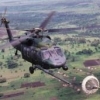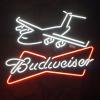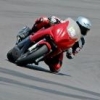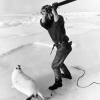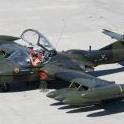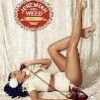Leaderboard
Popular Content
Showing content with the highest reputation on 04/05/2015 in all areas
-
In AFGSC the Huey crews regularly take missile maintenance personnel out to the sites to conduct short notice or after-hours repairs. The 341st Missile Wing’s ICBM complex in Montana is 13,000+ square miles and some sites take almost a 4 hour drive to reach, one way, hence the need for helicopters to provide security and support. Off-base convoys are used to transport the weapons from the sites to base in order for maintenance to be performed on the warheads. The helicopter squadrons regularly run into crew duty day issues on these long sorties due to the length of drive and ETIC times for the required maintenance actions at the site. For this reason a crew is usually designated to show six or so hours later than the primary crews to ensure that the convoy always had helicopter support. One bright, shining spring day I was scheduled to fly an instrument/EP sortie with a relatively new co-pilot. We were also scheduled to provide backup for the weapons convoy that was heading out to one of the furthest sites in the complex. We completed the training sortie without too many issues, an easy 2.5 with multiple beans logged and returned to the squadron to catch up on the standard Missile Wing queep. About an hour after we landed we got word that the convoy was delayed two hours due to MX, standard. Thirty minutes later the Ops Sup got a call from MOC requesting helicopter support for the affected site. A critical part forgot to be packed in the van the night before and the convoy wouldn’t be able to leave the site without it. Without a helicopter flight MMX would be forced to drive four hours to the site, deliver the part, as well as drive four hours back. This of course would exponentially increase the duty days of 14 aircrew and 100+ maintenance/security personnel currently sitting at said site awaiting the part. Our crew started to spin up for the mission; coordinating with MOC to determine the personnel and gear required, pre-flighted the aircraft, and other aircrew duties to be ready to turn blades as soon as the maintenance personnel got to the squadron. When the two maintenance guys arrived they were carrying their “critical component” in a pelican case the size of a hardback novel. We strapped in, cranked engines, and were in the air in ten minutes. The site was plugged into our trusty-rusty GPS and preceded Vne direct at a blistering 110 knots. As we were flying across rural Montana at 100 feet we started to converse with the airmen in the back. Neither of them had been in a helicopter before and we tried to make it the best flight that we could. The weather was warm enough that we could pin open the doors so they could get the best view of the countryside. We couldn’t deviate to sightsee too much because we had somewhere to be but on the return trip we would have plenty of gas to “explore the space” if you will. Almost an hour later we arrived on scene and landed right outside the launch facility gate. Both airmen ran out, threw the pelican case over the fence and ran back, and we pulled pitch with less than two minutes spent on the ground. We headed south into the mountains and started to show the airmen what a 9,000 pound, 45-year old Huey could do. Yanking and banking at 50 feet through the coulees and mountains is the best part of the job and we tried to put on a good show for the passengers. They were both sitting sideways in the alcove seats and with each bank and pull they would either see ground or sky but not much in-between. If you’re not ready it can be disorienting very quickly. We always brief the passengers to tell us when they’re getting sick so we can mellow out and they can fetch a barf-bag or let their symptoms settle. Many passengers though try and fight it as long as they can and when they notify the crew it’s usually too late. Unfortunately for the airmen on the left this was the case. He was barely able to get out a “slow it down” before he let it go. Fortunately though it was not too forceful and he made all of his lunch, leftover spaghetti squash casserole, in the bag. He tied it off and the FE jettisoned it to prevent it from being a FOD or biohazard. We mellowed out the flying as we cleared the mountains and re-entered the prairie. The airmen on the right ragged on his buddy for yarking persistently begging us to fly lower and turn tighter. After 20 minutes of this we relented and the left airman insisted that he was good and he promised that it wouldn’t happen again. The FE gave him another barf bag just in case and we started to have some fun. Ten minutes and many, many ridge crossings and whifferdills later, we asked how our passengers were doing. Both gave enthusiastic thumbs up so we decided to kick it up a notch. I took the controls and executed an aggressive, for a Huey at least, climb to 3000 feet AGL to set up for a spiral descent. A well-executed spiral descent will be at 60-80 degrees of bank, 2-ish Gs, and generate over 6,000 FPM rate of descent. The recovery will begin a few hundred feet above the ground and recover at 100-150 feet and 90 knots. Like the Chuck Yeager I emulated in those UPT standups 4 years prior I executed the first one like a boss. Rotor stayed loaded, VSI pegged out, and the blades popped so much on the recovery that Wagner would have been roused from the dead to conduct a zombie orchestra had he been buried outside of Lewistown, MT. Naturally the maintenance guys were excited for their afternoon roller coaster and asked for another. I gave the controls back to the co-pilot for his attempt. Now I had flown with this co-pilot before and tried to refine his spiral descents from a Maverick-stuck-in-the-jet-wash flat spin into something that wouldn’t make me fearful of mast-bumping from the near zero-G flight conditions. As we climbed back to altitude we checked with the passengers to ensure that they were feeling peachy and would be okay enduring the crushing G-forces. They again gave their A-OK and the co-pilot perched off the top and started his descent. Immediately things went wonky. The aircraft jerked and shuddered; unloading and reloading from the numerous rotor checks, throttle cracks, and overbanks as I tried to talk him through the maneuver execution. About three turns into the descent we were back into the flat spin headed out to sea. We spent the next 2000 feet of Class G airspace coaxing the aircraft back into parameters. As the radar altimeter passed through 700 feet he finally got the aircraft into a passable maneuver and we recovered about 300 feet above the ground. As we rolled out I saw what looked like grass trimmings flying around the cockpit and cabin. Only these grass trimmings stuck to the windshield and instruments glass. It was at this time that the FE began cursing repeatedly at us and Amn Snuffy in the left alcove. Unbeknownst to us in the cockpit, Amn Snuffy did not enjoy the co-pilots attempt at the maneuver. The erratic aircraft control and sub 1G flight did not sit well with his remaining lunch casserole. He attempted to get to the bag but the urges came on too fast to get it untied. As he puked the recirculating slipstream in the alcove, coupled with the unloaded flight condition kept his vomit in suspended animation in front of his face. As the copilot attempted to control the situation with a rotor check, the G-onset crashed this amorphous blob into his lap and aerosolized the chewed spaghetti squash into a green-out in the cabin of the helicopter. Every surface and object that was exposed including the pubs bags, helmet bags, and our FE was covered in half-inch pieces of Mrs. Amn Snuffy’s Thursday night meal. Luckily the smell wasn’t as bad as the cleanup would be. In the next 30 minutes all of the vomit dried and caked to whatever space it was currently occupying. After we landed and were hover-taxiing to parking we briefed both airmen on the proper etiquette and expectations for physiological incidents on the aircraft. The co-pilot and I shut down the aircraft as the FE ran to the phase-dock and returned with a pressure washer. They spent the next hour spraying the floor and scrubbing the inside of every nook and cranny of the aircraft, not to mention the bags and maintenance kits that were still caked in vomit particles. While they were cleaning we asked them what they thought of their afternoon. Even though they were covered in vomit and soaking wet from the pressure washer they said that they had the best afternoon yet in the ICBM world. Especially since their fellow MMX buddies still had 2.5 of driving left before they got back to base. Makes you appreciate that even the worst day of flying is still better than an afternoon in missiles.6 points
-
2 points
-
Reading stuff about RPAs/pilot shortage, made me recall an incident at my base about 10 yrs ago, that still infuriates me. A fighter pilot G-locs during a training sortie (at an operational sq). Wakes up just in time. The guy had a family, new kid etc. and had been struggling in the jet. Tells his leadership that he would like to volunteer to go fly RPA's when they were just starting up and needed people. Instead of letting a good motivated dude volunteer for RPA's, he got FEB'd, lost his wings, reflowed into an overcrowded shoe afsc and RIF'd a year later. Tough to feel bad for an organization that has manning woes after seeing shit like that.2 points
-
I speak Jive and Caveman, let me translate: Me like watches. Me have friend. Friend scared fly with me. Friend no want eject so me get watch.2 points
-
Rest in peace to my Uncle George Kopack who passed away last night. George, born in 1917, was a former US Army combat medic and was one of those that waded ashore in Normandy early on D-Day in 1944 and fought across Europe until the end of the war. George was a member of a different generation - the last of the five Kopack brothers to serve in WWII - and until the past ten years would walk the five miles each way to the VA Hospital in Wilkes Barre, PA, three or four times a week, year round - just because he didn't think any of the "old guys" in the hospital (most of whom were much younger than he) should have to be there alone. Salute George, until we meet again. Next time the drinks are on me.2 points
-
I grew up wearing my 2nd cousin's red POW/MIA bracelet, Maj Curtis 'Dan' Miller. He was an AC-130 pilot in the 16th SOS and was shot down on 29 Mar 1972. When I was just beginning pilot training in 2008, I received a call from my grandmother telling me that the government had identified his remains. The family was skeptical at first, because the JPRC has been known to be eager to close out MIA cases. They elected to have an independent lab verify the DNA analysis. Finally on 29 Mar 2010, 38 years to the day he was lost over Laos, Dan was laid to rest at the national cemetery in Ft. Worth. I remember it made national news and his funeral procession was over a mile long. It meant a lot to the family, his widow, and his mother to have such a heartfelt homecoming. His wife Sue told me the story of how the Air Force had a Colonel escort her to Hawaii and the lab showed her all of the work they did to identify his remains. There they had his entire service dress uniform made up, and placed his remains in the casket and sealed it. She said he was flown home on American Airlines and when they arrived in DFW, the entire ramp shut down while they held a ceremony and transported Dan to the funeral home. I traveled to Ft Worth for the funeral, and was amazed that the 16th SOS had quite a large showing and provided an airplane for the flyover. Now I wear a black KIA bracelet with Dan's name on it since he has finally been brought home. https://www.wfaa.com/story/local/2015/03/08/13559954/2 points
-
2 points
-
If I had to choose the dominant religion of Air Force officers, it would be non-religious. I'm sure many of us believe in the Christian God, but no one brings it up. I can literally count on one hand the number of times I've heard someone talking about Christianity at work. If a Muslim airman were ever discriminated against, it would be because they were religious in general, not because they were a member of the wrong religion. As far as race goes: same. Nobody gives a shit. The US military is probably one of the world's most diverse organizations without the newest diversity push. Only 10% of Army officers are black? Well, the US population is 13% black. Sounds about right, and nobody treats them any differently. The most important criteria for how well someone fits in, at least in an Air Force flying squadron, is still 1. How much of a bro you are and 2. Whether or not you're any good in the jet.1 point
-
Why? It's obviously working out for me. I mean it's not like there are any women or minorities that outrank me or anything..... Such a crock of shit.1 point
-
1 point
-
1 point
-
You spend a lot of time on both Air Force and Navy forums. I doubt any AF pilot spends as much time as you reading about another service. Since you obviously aren't a pilot, are you some military aviation fanboy or something? Dunno why I even ask, as we all know you won't respond.1 point
-
I don't think I know anyone who feels bad for the Air Force regarding manning woes. I feel plenty for the airmen who suffer the consequences of moronic decisions made by the Air Force.1 point
-
My favorite part of that class was when the instructor asked the class if it's ever OK to call a woman a bitch. One guy immediately said (very loudly), "Yeah. If she's being a bitch." I about lost it.1 point
-
A bit of the rest of the story from the traffic stop guy. https://news.yahoo.com/video/philadelphia-traffic-stop-caught-video-034331274.html1 point
-
They take the taskers from the MAJCOM and give it to the Wings. They are people-people.1 point
-
I speak jive... "Are there any watch aficionados (that fly in Martin-Baker equipped aircraft) who encounter crewmembers who are hesitant to fly with them.?"1 point
-
I believe your plan is pretty solid. Now, you just need to execute it.1 point
-
I remembered another one – I went through my log book and realized I totally brain dumped this one. It’s both a shit and puke story, so it’s a twofer. A good deal materializes in an otherwise routine month teaching fledgling Eagle drivers the ropes while stationed at Tyndall. IP cross-country!! Tyndall is having its annual open house/air show over the upcoming weekend. A 4-ship is needed to do a fly-by Sunday morning to kick off the day. Since the field will be closed over the weekend, the 4-ship needs to be elsewhere until needed that Sunday morning. In addition, Randolph AFB needs a flyby Friday afternoon. Tyndall closes Friday for show prep so we have to bug out Thursday afternoon. Our ONLY marching orders: Do the Randolph flyby Friday and make a 1200L TOT for the flyby at Tyndall on Sunday. Easy. The plan: 5-ship (1 air spare for Sunday). 4 – C-models and a D-model. Personal shotguns and golf clubs loaded in bay-5 (behind C-model seats). The jets are clean since we’re in the BFM phase and we decide to stay in the general vicinity of the Southeastern US. We’ll hit Ellington field Thursday night and spend some time on one of the largest sporting clay ranges in the country Friday morning. PM departure to hit the Randolph flyby and spend Friday night at the Auger Inn. Saturday morning on either the Randolph golf course or skeet range (maybe both). Sat PM departure to NAS New Orleans (conveniently close for Sunday flyby). Sunday morning 1100L takeoff for 1200 TOT continuing on to Patrick AFB for Sunday PM bikini contest on the beach. Monday RTB. The somewhat short notice on the whole affair leaves many of the bros without a kitchen pass that weekend and we were unable to fill the pit of the family model. After hearing this, our young, single intel officer (we’ll call him Fred) decides he wants to come along and see what’s so fun about this whole cross-country thing. Since D-models are in high demand at the FTU, Fred’s opportunities to get some time in the pit were few and far between. Even though he does have a few sorties under his belt and he’s never actually barfed in flight to that point, he’s a little concerned about airsickness. So, he grabs a bunch of barf bags, just in case. We load up and depart during the second go Thursday afternoon. We do a little VFR tour of southern Texas and arrive at Ellington that evening. Pacing ourselves that night, we grab some Tex-Mex with plenty of beans and of course several drinks. We spend much of the time advising Fred, who (according to him) is on his ”first real TDY”, to throttle back a bit. It’s going to be a long weekend. The next morning, we spend several hours blasting the shit out of helpless clay pigeons and depart that afternoon for Randolph. Since we don’t have far to go, it is decided that we will drop into Wichita Falls and beat up the pattern on the way to Randolph. The IP leading us is a euro-NATO alumni and thinks the studs will appreciate it. We scoff but get overruled. In order to ensure we have the gas to do the flyby, we skyhook at FL450 up to Sheppard. It’s been a while since his altitude chamber and according to 5-Alpha, Bravo’s digestive system appears to be incompatible with cabin altitudes in the range of FL180. Being a newbie to the single-seat flying world, Fred has done a poor job of shit management and is paying for that oversight dearly. A rapid descent to Sheppard pattern altitude in the Texas summer heat doesn’t help matters. Once the pattern has been suitably beaten there, we climb back up to observe the curvature of the earth on our way to Randolph. At this point, Fred looks and (according to 5A) smells like a giant turd in a flight suit. We get the report that Fred has shat himself over the aux-radio along with a request from Five to “push it up”. The airshow gods must have had sympathy for Fred, because when we arrive ready to do our best T-clone impression for the crowd it’s about 300-1 and the show is cancelled. ILS to a full-stop and when we shut down on the TA ramp, Fred is in full sprint to the Base ops bathroom before the turbines have stopped spinning. As it turns out, it was a minor shit-fart separator failure as opposed to a full up evac. 5-Alpha pulls me aside in base ops and offers me twenty bucks to take the D-model the next day. Fred comes out of the head trailing “eau de-farm animal” and I graciously decline. So, the night is looking up, Fred promises to show up at the club not smelling like a 2-year old and we are beer in hand at the Auger by 1900. Fred is stoked. He’s wearing a (clean) bag in the Auger, two vomit-free sorties under his belt and the whiskey is flowing. Probably as a result of a few hours at altitude and his extreme exuberance over the reality of Friday night in the fast-jet business, Fred overshoots the OBL. We manage to pour him into his Q-room later and decide to let him sleep in while we blast more clay targets the next morning and play a quick 9 before we leave. Fred rallies by departure time but is definitely looking a little rough while we file in base ops. He curls up on one of the couches in a fetal ball and might have had his thumb in his mouth when we woke him up to step. The afternoon flight to New Orleans is very gentlemanly and requires no trips to the ionosphere which is greatly appreciated by Fred. 5-alpha even let him fly for a while and he tried his hand at route formation. Fred would take the jet and immediately start climbing or descending out of formation. The hilarious part was, each time he starts flying, he asks, “Hey, where are those guys going?” The cumulative effects of the weekend so far were starting to have an effect on him, however. He was looking a little green when we landed, but he’s still 0 for 3 on barf bag usage. The marine duty driver gets us to our hotel one block off Bourbon Street and promises he will be there in the morning to pick us up at 0945L for our 1100L takeoff. Keeping in mind, the only reason we are out on this boondoggle is to do the Sunday flyby, we haven’t had to takeoff before noon since we left home station AND we’re in New Orleans on Saturday night, we are all aware of the potential for failure. Everyone promised to set their room alarm clocks while we were sober before we left the hotel that night. We quickly forget our concerns and hit the Big Easy. Fred is a N’awlins virgin and quickly decides he really, really likes hurricanes. Two hours and 6 hurricanes later, Fred is a blithering idiot and his lips look like he’s either a local cross-dresser or a 5 year-old who has OD’d on watermelon jolly ranchers. Since we went with the liquid dinner option, eventually some of the bros get the muchies and decide some craw-dads are in order. The place we went first wouldn’t let Fred in because he was too blotto. Someone had given him some kind of blue drink at the last bar that I’m pretty sure was pure grain alcohol. Think about that – how drunk does someone have to be to get refused service………IN NEW ORLEANS!! After some food, the drinking continued (at least by those who could still walk on their own). Since I wouldn’t trade jets with Five, he directed me to split North and get Fred back to the hotel since we were all rapidly losing any ability to care for anyone but ourselves. Fred was fully established in the “I love you man” phase of drunkenness by this point. By the time we were getting close to the hotel, he had transitioned to the “Crank up the Enola Gay” phase and was ready to pick a fight with anyone who would listen. We stopped twice so he could hurl. The first time, he ejected what looked to me like three whole craw-dads. I started laughing at him because they didn’t look like they had even been chewed. At least the shells were gone. I can also report that even when mixed with stomach acid, primary colors work. The combination of red hurricanes and whatever the blue death drink was did, in fact, make purple. I got him to his room and even remember to keep his room key since it was almost guaranteed he would need to be revived before departure. We got back to the hotel at some point and that’s all I have to say about that. Miraculously, the next morning, all five pilots were conscious and ready in the lobby at pickup time. Fred was back in the fetal position on the lobby couch after being pulled out of bed still in his clothes. 0945L came and went with no sign of the duty driver. Phone calls began shortly thereafter to attempt to find out where our ride was. We had given ourselves a 15 minute buffer, so no need to panic yet. However, as the minutes ticked by, we were watching our potential failure at our one and only mission loom on the horizon. We were finally able to determine that our driver had gotten a late start and gotten lost. We bit off on the “he’s 5 minutes out” for 20 minutes like a bunch of hungover idiots….wait, what? Just as we were about to exercise the taxi option, the driver finally showed at 1030, 45 minutes late. On the drive, individual duties were assigned to each guy and those duties were to be accomplished at the speed of light or faster, if possible. One guy would file, two guys were the bag stowing gurus, the other two would pre-flight all the jets and Fred would strap in. We got the driver to attempt a new land speed record and he dropped us by the jets at 1105L. Screeching to a halt in the parking lot, we scattered to our duty locations looking like an indy car pit crew (on Quaaludes). The rest of the ops looked like an Air Defense Alert scramble but slower. The first engine started turning at 1120 and we taxied quickly after that. Tower let us takeoff to the east and as soon as One got on the runway, he lit ‘em and blasted. The next two hadn’t made it to the runway yet, I (as Four) was just passing EOR and Five was leaving the TA ramp. Time now – 1135L. As I crossed the airfield boundary doing 400 knots and accelerating, I got a boresite lock on One. He was on my nose for about 8 miles with 200 knots of opening Vc. I came out of AB to stay sub-sonic and was able to hold about 650 knots in mil power as we slowly climbed. Range to One – 7.5 miles, 25 knots of closure. You do the math. It took me until abeam Eglin to get inside a mile. I'm sure ATC was highly impressed with this 5-ship of idiots staggered out in a 10 mile long string blasting across the Gulf of Mexico. For those unfamiliar with the amazing array of air to ground computer power available in the Eagle, we could have probably done better with a slide rule. TOT calculations were limited to a basic set up. You could get a “time to destination” in the HUD to whatever point was in the steer to INS window. That time was figured using your current ground speed based on the actual conditions at that moment. Destination “B” was usually home base and as I lifted off and began to try to catch One, I selected that and the appropriate mode to give me the data in the HUD. While I was still accelerating, my heart sank and failure appeared imminent as I looked at the time to destination which read 32 minutes. Time now 1137. TOT 1200. Muthaf…..we are so, totally, totally screwed. As I continued to gradually climb and rapidly accelerate to the little known cross-country, gotta make an airshow tech order climb speed of 650 knots, I noticed the time to destination beginning to look better. By the time I stabilized in my race to catch One, it now looked like we might arrive abeam Tyndall with about 2 minutes to spare. Okay, maybe it won’t be real pretty but we’ll fill the square. Halfway to Tyndall and still about 4 miles back from One, we changed freqs in an attempt to contact the Airboss. For the show that day, the Airboss was a squadron pilot named “Hoss”. Now Hoss was a big fella and a little rotund, filling out his flight suit quite well. He looked more like a USAF version of Friar Tuck than an F-15 pilot. He would be positioned in the SOF truck acting as the ground FAC for the fly by. The SOF truck was equipped with the standard one each, UHF radio as expected. After numerous unsuccessful attempts to raise him after getting airborne, we finally got him. We could picture his round, smiling face as we finally heard his jolly, booming voice come across the frequency about the time we were abeam Eglin AFB. 60 miles and 8 minutes to get there. Holy shit, this might just work. “Eagle 11, Airboss… I’ve been trying to call you for 30 minutes”. “Ah, yeah, sorry about that – long story.” “We have a 15 minute rolex, I say again, a 15 minute rolex”. 5 sets of throttles hit the idle stop at about the same time as we attempted to save some of the JP-8 we had been spewing out the back like a fire hose for the last 20 minutes. Lack of closure problem finally solved. We coordinated with approach to hold in one of the MOAs to the west of the field since the flyby was to the east. Five held high as the 4-ship got into fingertip and tried to fly something that looked marginally presentable. As One was making his slide rule calculations and planning his final turn inbound for the run, we got another call from the Airboss with another 10 minute rolex. During this final 10 minutes, we got some additional info from Hoss about the location of the band, the color guard and the guests of honor. We were getting a pretty good running commentary on the situation and it looked like this would be it. Inside of 5 minutes to the new TOT and Hoss gave us an exasperated call indicating another possible delay… a pause and then….”standby”. Reaching the front of the MOA with no further word, One began a turn cold back into the area. All through this turn, he attempted to raise Hoss. “Airboss, Eagle 11” “Airboss, Eagle 11” Rolling out of the turn, pointing away from Tyndall, he was still unable to raise Hoss. “Airboss, Eagle 11”………..Nothing. Suddenly, a new, female, timid, non-Hoss –like voice came over the frequency. “Eagle 11, uh… this is Airman Jones…..The radio in the SOF truck stopped working and he’s running to a different truck……but, the music has started.” So many, many things flashed through my mind in the next few seconds. First was, of course – ah shit! Second was, who is Airman Jones…she sounds kind of hot. Third, was incredulity as I attempted to picture Hoss running….anywhere. The thought of his round, now red face as he huffed, puffed and pounded across the tarmac toward whatever vehicle might have an operable radio was hilarious. Last, was a little more complicated. You know the hero shots on display in the Squadron or Wing buildings with aerial photographs of the unit aircraft in action? Inevitably there is usually one photo taken on initial from the number two aircraft. Number One has just pitched out and is belly up to the camera, 90 degrees of bank about to bend his jet around to inside downwind. So, it’s a face full of aircraft belly a wingspan-ish away. Cool, right? Well, that’s what One looked like the instant after Airman Jones called. The only major, but important difference was Three and I were looking at the top of his jet, not the bottom and it was coming our way fast. So, not cool. He racked his jet up to get us turned around and I think both three and I saw our miserable lives flash before us as we bunted – hard - to keep living an extra few seconds. The rest was pretty anticlimactic. We flew inbound, never heard from Hoss, descended through an undercast and popped out a mile from the ramp. We did the fly by and never even knew our status. No one said shit to us when we got back, so I guess it was okay. We didn’t feel the need to share too much either. We rejoined with Five and started east. Weather from Tydnall to Patrick was total DS so we split into 3 and 2, got separate clearances and flew over there IMC. We had been so focused on the airshow issue, no one had even thought to wonder about Fred. Since I was leading Five now, I had a few brain cells left on life support and began to wonder how he was doing. I looked over at him and he gave me a thumbs up - so I guess, okay. We had a way to go and if Five felt like I did, the last thing he was going to want was 30 minutes in fingertip in the weather, so I cleared him to drag back to radar trail. That decision was critical for Fred. I’m no expert on the workings of the inner ear, but I can say, in Fred’s case, having another aircraft for attitude reference is a good thing. Pulling the power, popping the boards, deceleration, acceleration, all while IMC and making the aircraft for reference go away?….bad…..very, very bad. I’m sure the aftereffects of his first night on Bourbon street as well as the cross-country up to that point had a lot to do with it as well. Fred was not capable of going cold mic and Five cursed me silently from 2 miles back for refusing the D-model as he listened to every retch. If he had live missiles, it’s possible I may not be here writing this now. Considering none of us had eaten anything since the craw-dads the night before, it was kind of amazing there was much available. Especially since Fred had already made a couple of deposits back on Bourbon street. Unlike my negative-G pal in Germany, Fred managed to make do with just one bag. We finally cleared the weather, rejoined and came up initial at Patrick. As we flew in fingertip, he held it up proudly from the back seat as I laughed into my mask. After we landed and we were heading inside, Fred walked by me carrying his craw-dad surprise. I could be wrong, but I’m pretty sure the damn thing had a slightly purple tint to it through the bag.1 point
-
I've never puked in an airplane, but once I came really close. Flying the AC-130H we typically tried to squeeze as much training into a five hour sortie as possible. One summer night I was a new AC in the Gunpig flying a Live Fire, Dry Fire, Pilot Pro mission at Hurlburt. The aircraft recently had some recurring sensor issues that maintenance had tried everything they could think of to fix. As a result they added a female sensor maintenance troop to observe the system in flight and make sure it was truly repaired. The Spectre has no real air conditioning to speak of and the start of a summer sortie was like sitting in a car in the hot sun with the windows rolled up typically you were drenched from head to ass crack, but we didn't care we were flying a freaking gunship! Once airborne we would climb to 6000 feet and slowly cool down over the next hour as we proceeded to the H area and knocked out a sensor alignment. Over the next fours hours you would be mostly comfortable as you conducted your live fire and dry fire, but once you dropped back down for pilot pro, the airplane would start to heat up again. On this particular night we had an IP and two extra copilots who needed some approaches for currencies. I flew most of the dry fire and half the live fire before getting out of the seat for the IP to grab the second half of the live fire and get set up for the pilot pro. I made my way down to the booth where the TV, IR, and EWO sit so I could strap into the red seats for the pilot pro. Unlike other C-130's most of the interior is filled with guns and at the time the only extra seats were pull up floor seats which meant sitting on bare metal for copilot pilot pro (a suicide mission at best), or one of the few red seats in the booth. While the choice might seem obvious, sitting in the booth was no picnic. There is absolutely no view outside the aircraft, it was even hotter in the booth than the rest of the aircraft, and the inhabitants of the booth are a very special and very sadistic breed. I opened the door of the booth to grab a seat and the female sensor maintenance troop was sitting on the end closest to the door so she could see the TV display. She was a bigger girl and when I sat down next to her there was not a lot of spare room and our legs were actually touching. We made our way back to the radar pattern, knocked out our decent checklist and dropped down to fly a few instrument approaches before jumping into the VFR pattern. On the first approach I made the mistake of looking over at the IR display as we were coming into the flair. Having been in the booth before I knew some of the sensor operators liked to screw with each other in the booth and would track the runway with the sensor, just after touchdown they would roll the sensor sideways or under the aircraft, if you weren't prepared the visual allusion would make you feel like the aircraft was doing something it should not. One of the more sadistic sensor operators was running the IR that night and he was having a good ole time screwing around so I looked away and focused on something else. The booth was getting hotter by the minute and the smell of rubber from the tires was overwhelming. Again, the AC-130H is different from other C-130's and with all of the holes and openings for sensors, guns, and other equipment, things like tire and gunsmoke instantly fill the inside of the aircraft. I've been on live fires with the 20MMs firing where you could not see the back of the airplane from the smoke. Not related to puke, but I must mention in passing how much fun the 20MMs were to shoot. We could put both 20's on the line with the 40MM at the same time and the result was staggering, 4100 rounds per minute of death raining down...the best part was the 20MM were pilots weapons, bolted to the floor unlike the other guns that were on trainable mounts and slewed to wherever the sensor was pointing. As I mentioned earlier, the airflow inside the plane was such that the gun gas filled the inside, for the pilot in particular the effect was even better because the gun gas from the 20MM's rushed forward onto the flight deck and curled over your head and in front of the HUD while you were shooting. I will never forget the smell or the instant stiffy that followed, I loved that plane. Flashing back to that mission....I was doing my best not to watch the sick fuck sensors as they played their game I noticed and when I looked to the right I noticed the maintenance troop was sweating profusely, in fact, I could feel it on my leg...her nasty sweaty leg rubbing on mine...combined with the tire smoke and sensor operator constantly rolling the ball...for the first time in my career I was feeling less than perfect. I took a drink water and tried to think of something else as we came in for another touch and go, just as the tires touched the runway and a rush of smoke and stink hit the booth I heard a roaring noise coming from my right and barely snapped my head around in time to see a rope of projectile vomit coming out of every facial orifice on the maintenance troop and on to my LEG! It was surreal and it took a minute for my pea brain to process the wet hot vomit soaking my flight suit and running down my leg. In an instant I realized what had happened and suddenly I felt my own vomit rising up...it took every bit of self-control and mind power to prevent my own giant chunder in the booth. If not for the fear of severe embarrassment in the squadron I would have sprayed her like a car wash. Mercifully the booth called up and the IP decided we had enough training, the next one was to a full stop...after we blocked in I skipped the MX debrief and spent 10 minutes in the parking lot taking a shower with the hose. Ahhh the things I will miss when I retire.1 point
-
1 point
-
-1 points
-
Regarding recent O-4 board--higher promo % overall (92), but lower school select % (16). Masking grad school info had the desired result: for the bottom 20% of bubbas with a P, they competed on their official records. Officers from non-ops career fields have 5 distinct advantages in both the competition for DPs and the O-4 board itself: 1) 100% have been Flight Commanders and supervised other people, which is not the case in ops. I expect that the non-selects for O-4 were not cycled through the Mickey Mouse flight command positions (A/B/C Flt vs DOV, DOT, etc) in their ops squadrons; 2) Non-ops have spent their entire careers trying to articulate their value to the broader AF. Everyone has an important role to play, but It is more of a stretch that a FSS 1Lt advances the national interests of the US than the officers in the OG. Every CGOM/CGOQ/CGOY/functional awards package requires them to think about and to justify their operational-to-strategic impact that is assumed away by many operators. 3) Ops bubbas do not get the same credit for deployed experience. Most non-ops folks have deployed to IZ and Afghan, while many (not all) ops frames supported from bases in other countries. Similar to #2 above, ops records--OPRs & citations--often use MDS-specific language and assume that the reader knows both the mission sets as well as the officer's role in that mission. 4) Ops communities have trouble weeding out folks due to ADSCs. Non-ops career fields have more weed-out options due to the shorter ADSC. 5) Competing for O-4 from a staff billet. Smaller pool of officers for strats/DPs, but their Sr Raters will probably be FO/GOs. Grad school, SOS, performance in combat was not masked for the Sr Rater/Wg CC to give out DPs to the top 75% or to fight for folks on the bubble at the MLR.-1 points
-
Both Arnold & Spaatz served as execs, went to school, did their staff time, and still had time to be effective combat leaders.-2 points
-
I have a difficult time understanding privilege. I define it as a psychological weight when you are a member of a significant and obvious minority. In the Air Force, there would be white, male, and Christian privilege. But what can I do about the psychological weight of someone else? Where you have significant minorities--gender, race, religion--our AF community contains large elements that are prejudiced against them. That prejudice sometimes manifests in obvious or subtle discrimination. It is the discriminatory actions that are the real problem, and we must be aggressive in finding and rooting it out. Bias, prejudice, and privilege are good to understand as the foundation for later discrimination, but I don't think we can do much about them. People can think and believe in whatever crazy nonsense that they want; it is taking action on them that becomes a serious problem for the rest of us.-5 points

